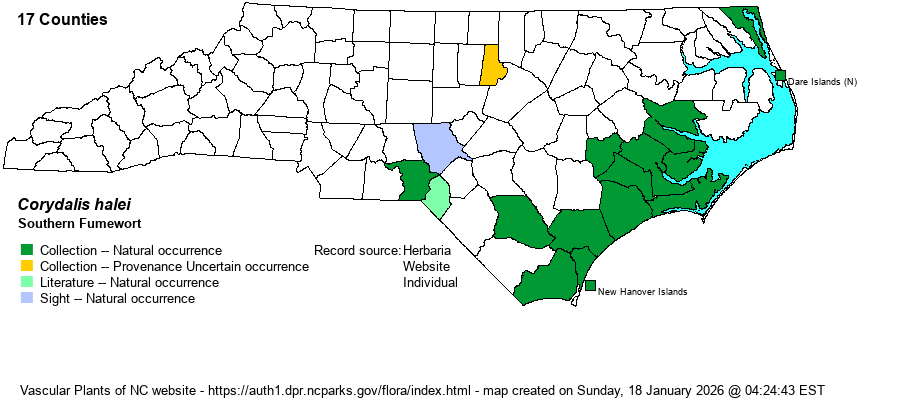| Section 6 » Family Fumariaceae |
Show/Hide Synonym
| taxonName | relationship | relatedTaxonName | relatedTaxonRefText | relComments |
|---|
|
| Corydalis halei | = | Corydalis micrantha ssp. australis | Flora of North America (1993b, 1997, 2000, 2002a, 2002b, 2003a, 2004b, 2005, 2006a, 2006b, 2006c, 2007a, 2009, 2010) | | | Corydalis halei | = | Corydalis micrantha ssp. australis | | | | Corydalis halei | = | Corydalis micrantha ssp. australis | | | | Corydalis halei | = | Corydalis micrantha ssp. australis | | | | Corydalis halei | = | Corydalis micrantha ssp. australis | Radford, Ahles, and Bell (1968) | | | Corydalis halei | = | Corydalis micrantha ssp. australis | Wunderlin & Hansen Flora of Florida (3) | | | Corydalis halei | = | Corydalis micrantha ssp. australis | Lidén in Kubitzki, Rohwer, & Bittrich (1993). [also see Capnoides] | | | Corydalis halei | = | Corydalis micrantha var. australis | Gleason and Cronquist (1991) | | | Corydalis halei | < | Corydalis micrantha | Gleason (1952) | | | Corydalis halei | > | Corydalis halei | | | | Corydalis halei | > | Corydalis micrantha ssp. australis | | | | Corydalis halei | = | Capnoides halei | Small (1933, 1938) | | | Source: Weakley's Flora |
|
| Author | (Small) Fernald & Schubert | |
| Distribution | This species is limited to the Coastal Plain, essentially the southeastern portion, sparingly north to coastal Dare and Currituck counties. It ranges inland to the Sandhills region, west to Moore and Richmond counties.
This is a Southern species, ranging from eastern NC south to FL and TX, and northward far inland to IL and MO. | |
| Abundance | Uncommon in the lower Coastal Plain, mainly in coastal counties, north to Currituck County; rare farther inland to the Sandhills region, despite much suitable habitat in this southwestern part of the Coastal Plain. As NatureServe (= BONAP) does not consider it a valid taxon, the website editors have recommended a Global Rank of G5?. | |
| Habitat | This is the only native member of the family (Fumariaceae) that grows in sandy soil, and mostly disturbed soil at that. It is most often found on sandy roadsides, in other clearings, and along sandy margins of woods, especially along and near the coast. | |
| Phenology | Blooms in March and April, and fruits shortly after flowering. The plants have withered from view by the end of April, in most places. | |
| Identification | This species and C. micrantha are quite similar, and rather similar also to C. flavula. The plants are mostly erect, but only reach about 4-5 inches tall. The leaves are bi-pinnately dissected into small, finger-like segments. This species has the terminal inflorescences (at each branch) extending well beyond the leaves, owing to a long stalk; C. micrantha and C. flavula have the flowers barely exceeding the leaves. The flowers are bright golden-yellow, horizontally-facing, tubular, and about 1/2-inch long, with a fairly long spur -- essentially like that of C. micrantha. In these two species, the fruits are ascending or erect, whereas the fruits in C. flavula are drooping. C. halei has capsules mostly 2/3-inch (15-20 mm) long, whereas those in C. micrantha are about 1/2-inch (10-15 mm) long. C. halei has strongly glaucous leaves, being pale green, whereas the other two species are generally bright green in color. Lastly, the habitats differ -- C. halei is a plant of sandy Coastal Plain roadsides, C. micrantha of montane and upper Piedmont rocky places, and C. flavula of rich bottomland and lower slope forests. Not surprisingly, when this species is encountered, it seems to be an exotic species as it grows in weedy or disturbed places. | |
| Taxonomic Comments | Many or most references include it within C. micrantha, often listed as C. micrantha ssp. australis. BONAP does not list it as a species.
| |
| Other Common Name(s) | Southern Corydalis, Smallflower Fumewort | |
| State Rank | S3 | |
| Global Rank | GNR [G5?] | |
| State Status | | |
| US Status | | |
| USACE-agcp | | |
| USACE-emp | | |

